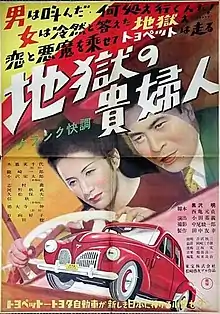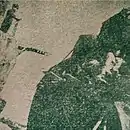Lady from Hell
Lady from Hell (Japanese: 地獄の貴婦人, Hepburn: Jigoku no Kifujin) is a 1949 Japanese action drama film directed by Motoyoshi Oda and co-written by Akira Kurosawa, with special effects by Eiji Tsuburaya. The film has been called a "protest movie" which "portrayed a cornucopia of corruption and indicted every known example of postwar exploitation: black-marketeering, crooked politicians, blackmailing journalists, and a decaying aristocracy."[3] Lady of Hell is regarded as one of Oda's most celebrated films.[4]
| Lady from Hell | |
|---|---|
 Theatrical release poster | |
| Directed by | Motoyoshi Oda |
| Screenplay by | Akira Kurosawa[1] Motosada Nishiki[2] |
| Produced by | Tomoyuki Tanaka[2] Keiji Matsuzaki |
| Starring | Michiyo Kogure Eitaro Ozawa Takashi Shimura |
| Cinematography | Shunichiro Nakao[2] |
| Music by | Ryōichi Hattori[2] |
Production companies | |
| Distributed by | Toho |
Release date | March 15, 1949 (Japan) |
Running time | 72 minutes[2] |
| Country | Japan |
| Language | Japanese |
Plot
It has been three and a half years since Hiroshima and Nagasaki were bombed, and Japan's economy is no longer growing slowly due to inflation. To balance the fiscal balance, the tax authorities have organized a "T-men" squad to detect tax evasion, the biggest cause of inflation. The building is called Fujimura Sangyo and it is located in front of it. As a group of T Men are inspecting the books in the office, Yoshioka, Kano, Mihara and others are accompanied by the police; however, the double books in question are not present. A few minutes later Fujimura, the company's president, walks in and laughs meaninglessly. The economic paper's Tachibana, however, persists in his attachment to Fujimura. Former Countess Mibu and Center Party executive Nango have been dating for some time. She's also on Fujimura's radar. In the world of political parties and Fujimura Sangyo, a close relationship led to an entanglement involving Mrs Mibu, centred on "double books." Journalist Tachibana recognized the link between Nango and Fujimura Sangyo. In cooperation with Yoshioka and other members of "T Men," he began looking for the whereabouts of the double books, but Fujimura failed to reveal any evidence. Reporter Tachibana suddenly disappeared, leaving behind the news that he had captured a certain point. Major action has been initiated between the police and "T Men." Nango also suffered from money and women, like Fujimura and his friends. To gain power, Fujimura will do whatever he thinks is right. Fujimura finally takes Mrs Mibu out of Nango. Nango can't let go of Miss Mibu, but at the same time follow them to Atami, and then follow them to "T Men". A group of police officers. Fujimura's death caused Nango and Mrs Mibu to settle everything after Tachibana's murder. The "T-men" muttered, "The future is important."
Cast
- Eitarō Ozawa as Fujimura[5]
- Michiyo Kogure as Mrs. Mibu[5]
- Akitake Kōno as Tachibana[5]
- Takashi Shimura as Chief of Police[5]
- Minoru Takada as Doi[5]
- Shin Tokudaiji as Yoshioka[5]
- Ichiro Ryuzaki as Nango[5]
- Kinzō Shin as Kano[5]
- Yasuo Hisamatsu as Mihara[5]
Production
Crew
- Motoyoshi Oda – director
- Eiji Tsuburaya – special effects director
- Tomoyuki Tanaka – producer
- Akira Kurosawa – screenwriter
- Minoru Esaka – art director
- Akira Watanabe – special effects art director
Personnel taken from Eiga.com.[5]
Development


The film is one of Toho's first films to use heavy special effects, the technology was then reused for the 1954 Godzilla film. The film's screenplay was co-written by Akira Kurosawa and Motosada Nishiki.
Release
References
- Anderson, Joseph L.; Richie, Donald (2018). The Japanese Film: Art and Industry. Princeton University Press. p. 187. ISBN 978-0-691-18746-4. Retrieved 20 September 2020.
- Galbraith IV 2008, p. 70.
- Chapman, William (1991). Inventing Japan: The Making of a Postwar Civilization. Prentice Hall Press. p. 55. ISBN 0-13-942921-2. Retrieved 20 September 2020.
- Ryfle 1998, p. 62.
- "地獄の貴婦人(1949): 作品情報". 映画.com (in Japanese). Retrieved July 11, 2021.
- "黒澤明DVDコレクション全国版 (2019年11月3日号)". 紀伊國屋書店ウェブストア|オンライン書店|本、雑誌の通販、電子書籍ストア (in Japanese). Retrieved 2021-07-11.
Sources
- Galbraith IV, Stuart (2008). The Toho Studios Story: A History and Complete Filmography. Scarecrow Press. ISBN 978-1-4616-7374-3.
- Ryfle, Steve (1998). Japan's Favorite Mon-Star: The Unauthorized Biography of the Big G. ECW Press. ISBN 1-55022-348-8.
External links
- Lady from Hell at IMDb
- "地獄の貴婦人 (Jigoku no kifujin)" (in Japanese). Japanese Movie Database.